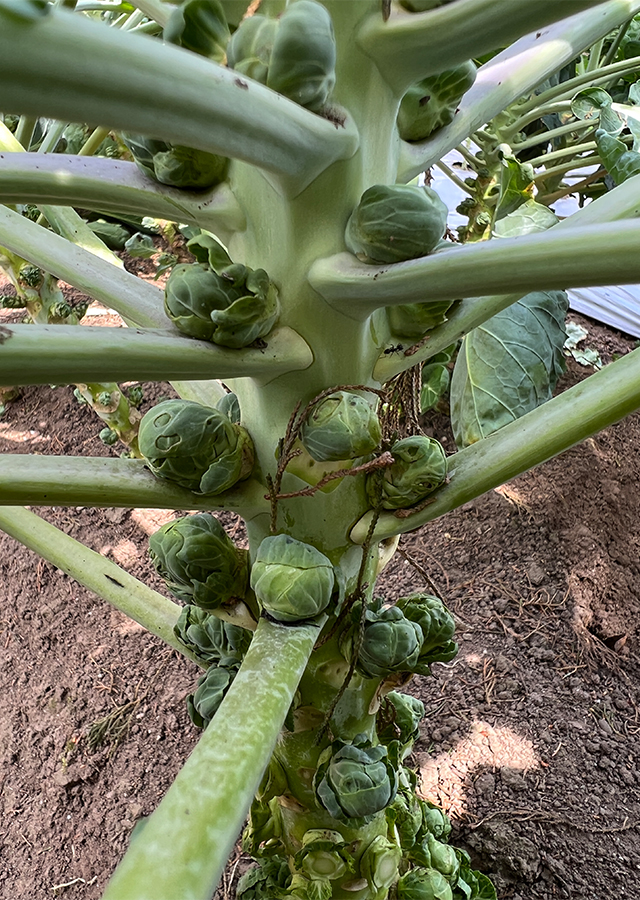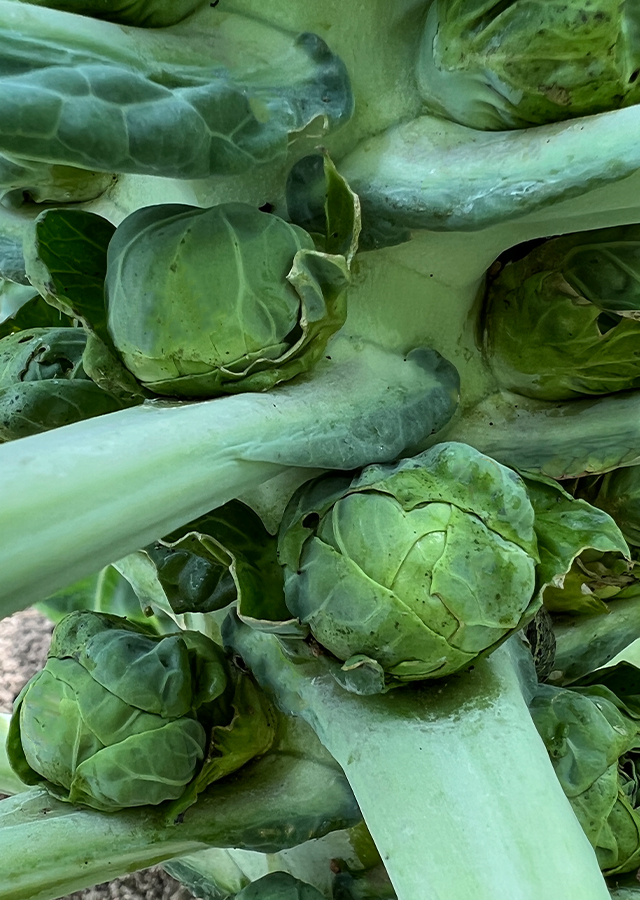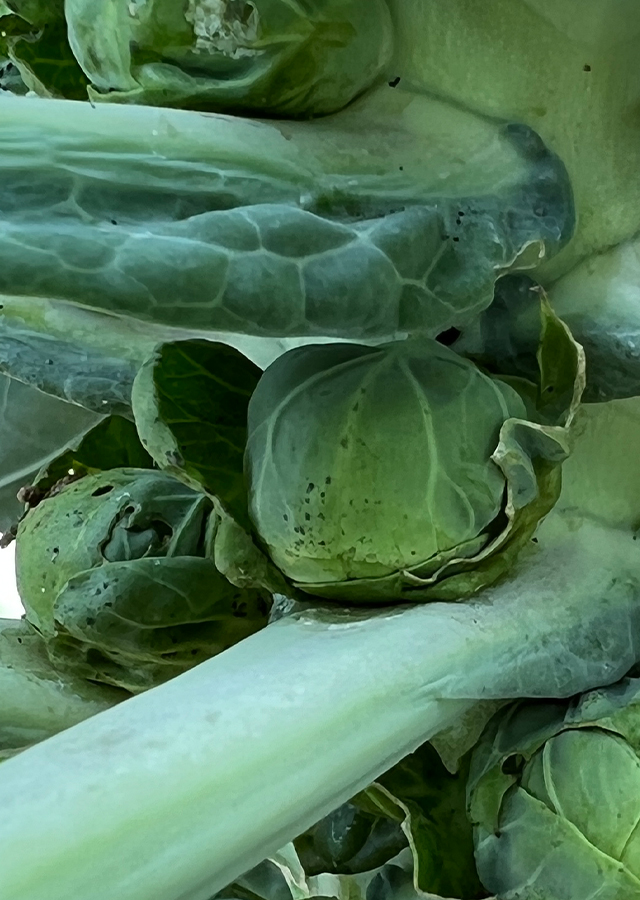Brussel Sprouts
Brassica oleracea var. gemmifera DC.
Brassicaceae
Location in our garden
Vegetable



Synonym
-
Habitus
Herbaceous. An annual or biennial cruciferous plant that grows 60-90 cm tall
Part Used
Leaves
Growing Requirements
Full Sunshine
Need Shade
Habitat
Mountains
Terrestrial
Overview
Brassica oleracea var. gemmifera, with common name Brussel sprouts, as its name suggests, originated in Belgium, probably near Brussels. Genus name comes from the classical Latin name for cabbage. Specific epithet means of vegetable gardens. Although Brussels sprouts were allegedly sold in Belgian markets as early as the 13th century, they did not become commercially important until the 19th century. This vegetable, although a popular vegetable in England and its continents, is sparingly cultivated in the United States of America. From Belgium, it has been introduced to England (1810). Some parts of Long Islands in New York are also well known for Brussels Sprouts production. In India, it is widely grown in Kodaikanal and Nilgiri hills of Tamil Nadu and Maharashtra. It is thought to have been derived from wild cabbage. It is used for food and beverage (vegetables), and for medicinal. Both the sprouts and their leaves can be cooked. Brussels sprouts are low in calories, rich in protein and high fiber. A half cup of sprouts provides 80% of the recommended supply of vitamin C, vitamin A, potassium, folate, iron, and fiber.
Vernacular Names
Col de Bruselas (Spanish), Chou de Bruxelles (French), Cavolo di Bruxelles (Italian), Rosen- Kohl (German), Spruitkool (Netherlands), Me kiyabetsu (Japanese), Bao zi gan lan (Chinese).
Agroecology
Brussels sprouts is a slow-growing, long-season vegetable crop. Best grown in organically rich, fertile, consistently moist, well-composted, well-drained loams in full sun. It requires cool weather for best growth. Warm weather causes individual sprouts to be soft and open rather than solid and tightly packed. Prefers soil pH of 6.5.
Morphology
- Root - shallow roots.
- Stem - having a stout stem studded with budlike heads of tightly folded leaves, resembling tiny cabbages. The buds are light green to green/blue in colour. The round sprouts are about walnut size, about 2-5 cm across, and are composed of tightly packed leaves
- Leaves - long, large, smooth and leathery leaves which can be green to purple in colour and are arranged alternately on the stem.
- Flower - yellow flowers with four petals.
- Fruit - silique fruits containing seeds.
Cultivation
- Generatively propagated by seed.
- Plants should be spaced in rows about 45 cm apart with 7.5 cm between each row. Keep soils uniformly moist throughout the summer. Apply nitrogen fertilizer at 2-3 week intervals during July and August. Some leaf removal is often done as the sprouts begin to develop. Sprouts are best harvested after the first fall frost (flavor improves after frost). Apply mulch around plants to protect the shallow roots, reduce weeds and retain soil moisture. Rotate crops to avoid soil borne diseases.
Chemical Constituents
Polyphenols, β-Carotene, lutein-zeaxanthin, sulforaphane, niacin, ptiaminyridoxine, thiamine, and folate.
Traditional Medicinal Uses
- In Traditional Chinese Medicine (TCM), Brussels sprouts are used to improve digestive health.
- It contains a high supply of phytonutrients and antioxidant which may help prevent cancer, protect eye and skin health, boost the immune system, provide bone-building, and protect the lining of the stomach.
- Its antiinflammatory agent can improve conditions in Crohn's disease, inflammatory bowel disease, irritable bowel syndrome, obesity, type-2 diabetes, and ulcerative colitis, and also fight heart disease.
Part Used
Reference Sources
- CAB International. (2022). Invasive Species Compendium: Brassica oleracea var. gemmifera (Brussels sprouts). https://www.cabi.org/isc/datasheet/10106. 09-11-2022.
- Doniec, Joanna, et al. (2022). Hydrothermal Treatment Effect on Antioxidant activity and Polyphenols Concentration and Profile of Brussels sprouts (Brassica oleracea var. gemmifera) in an In Vitro Simulated Gastrointestinal Digestion Model. MDPI. https://doi.org/10.3390/antiox11030446. https://www.mdpi.com/2076-3921/11/3/446/htm. 09-11-2022.
- Heritage Garden. (No date). BRUSSEL SPROUTS (BRASSICA OLERACEA VAR. GEMMIFERA). http://heritagegarden.uic.edu/brussel-sprouts. 09-11-2022.
- Kew Royal Botanic Gardens. (No date). Plants of the World Online: Brassica oleracea var. gemmifera DC.. https://powo.science.kew.org/taxon/urn:lsid:ipni.org:names:77106805-1. 09-11-2022.
- Levy, Jillian. (2019). Brussels Sprouts Nutrition: Disease-Fighter or Thyroid Disruptor? https://draxe.com/nutrition/brussels-sprouts-nutrition/. 09-11-2022.
- Missouri Botanical Garden. (No date). Brassica oleracea (Gemmifera Group). http://www.missouribotanicalgarden.org/PlantFinder/PlantFinderDetails.aspx?taxonid=269744&isprofile=0&cv. 09-11-2022.
- Tewari, Vatsala, et al. (2020). BRUSSELS SPROUTS: ORIGIN AND PRODUCTION TECHNOLOGY. Times of Agriculture. A Resonance in AgricultureOctober, 2020/Issue-6/Page101-107. https://www.researchgate.net/publication/344800632_BRUSSELS_SPROUTS_ORIGIN_AND_PRODUCTION_TECHNOLOGY. 09-11.2022.
- Walkey, D.G.A., and Pink, D.A.C. (No date). Brussels Sprout (Brassica oleracea yare gemmifera) and Broccoli (B. oleracea yare italica). https://link.springer.com/chapter/10.1007/978-3-642-73520-2_12. 09-11-2022.
